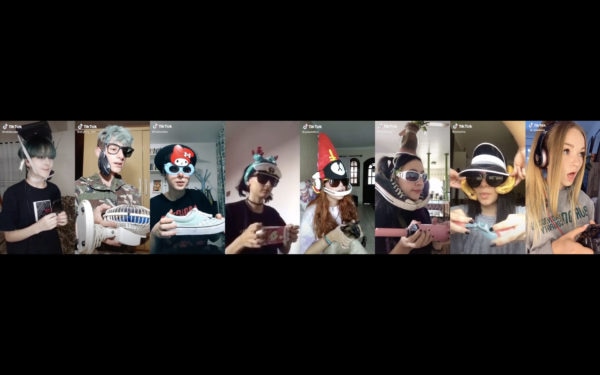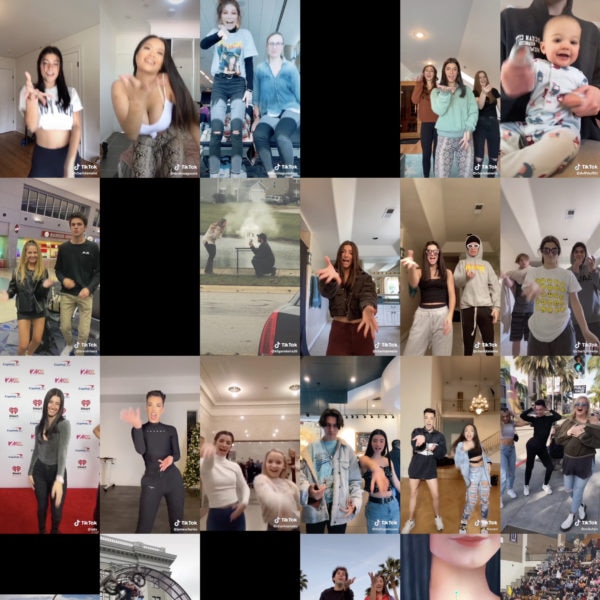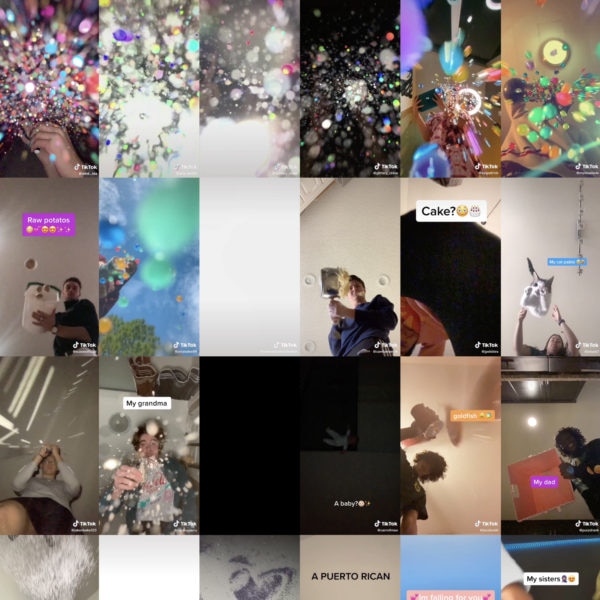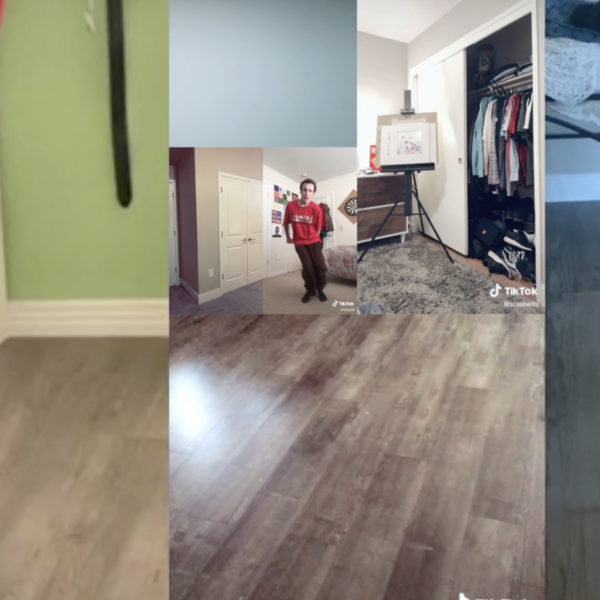About a year ago I started collecting links to TikToks I liked in the Notes app of my phone—creating a personal archive of videos I deemed interesting or specific to the platform. This spring, Ibo Ibelings, a creative programmer with whom I shared a studio space at the time, wrote a script that allowed me to download the videos from this list all at once.
Over the last few months the script would sometimes stop working, as TikTok would patch their website to prevent downloads, forcing us to make changes to the script. When youtube-dl, a tool for downloading online content we were using, could not keep up with TikTok’s patches anymore we switched to a TikTok scraper that Andrew Nord built and published on GitHub. A great advantage of his software was that it allowed for bulk scraping for sounds. On both TikTok’s app and their website there are dedicated pages, with a unique ID, that list all videos made using a certain audio clip ranked by the amount of likes. With the TikTok scraper I could now simultaneously download the most popular TikToks, which were using a certain sound, without having to manually copy and paste the links of each video onto a list. Being presented with this new opportunity to automatically download TikTok videos, I knew I wanted to use it for this ‘image contribution’. On TikTok you can only watch one video at a time, as you scroll vertically through the app. Putting a multitude of videos next to each other, in parallel, might give a new overview and perspective on TikTok’s content.
The resulting image contribution consists of four high resolution video collages that can be seen on the linked webpages—allowing you to interact with, and scroll through, them. The collages reflect different sides, moments, and functionalities of TikTok. Each collage is titled after a sound on the app that all the corresponding videos in the collage use as their audio.
Because TikTok is always in flux, it has around 50 million daily active users in the U.S. alone, looking at the most popular videos using a certain sound was not always representative of the experience I had on my For You page. For instance, a url to a sound I saved over a month ago now had loads of pretty boring videos at the top which I had never seen. But when I originally saved it, the top videos were all ones that followed the same, funny format. Therefore, for some collages, I included some TikToks from my personal archive, or used the app to track back all videos in a so-called “duet chain”.
1. Original Sound: contains music from ‘No Mercy (feat. BlackGryph0n & LittleJayneyCakes)’ by The Living Tombstone
The original duet feature in TikTok lets you record a video response right next to the original video. When users keep doing this, a so-called “duet chain” starts to form. In this collage, one of those duet chains is taken as the starting point. Usually, the appearance of the first videos in a duet chain become smaller with each duet as the chain goes on, but here all videos are expanded to their original size again so you can see them well. The sound originates from the nerdy song “No Mercy” by The Living Tombstone. The song is about the video game Overwatch and was posted on a YouTube channel about games and geek culture in early 2017. Back then, in October 2018, TikTok’s user base was more composed of fringe online communities like cosplayers than content mansion inhabitants. After a number of cosplayers made a TikTok to this song, @xoxoliana did the same. What happened next was that ‘real gamers’ got mad at her for using a Playstation 3 controller in the video, while Overwatch was not even available on that platform. They started duetting the video, making fun of her with gaming setups that made even less sense. It’s hard to tell if all the videos made as part of this trend have the same misogynistic intent as the first ones. Or if, when the trend started to become more famous than the original video, it just became a fun game for anyone to join in on and make the most ridiculous video as a response.

2. Lottery – @K Camp (Renegade)
TikTok is probably best known for its dance videos. This one, the Renegade, might be the most famous one. It played a big part in the rise of Charli D’Amelio, whose version of the dance became a hit, and who recently became the first person on the platform to reach 100 million followers. The dance was very popular from late 2019 to early 2020 when the platform had a huge growth in users in the U.S. It also coincided with the launch of the Hype House in December 2019, the first TikTok creator mansion and which D’Amelio was part of as well.
The dance routine is not without controversy. The version of the dance D’Amelio popularised was based on a more difficult choreography created by Jalaiah Harmon, who was 14 years old at the time and went uncredited in D’Amelio’s TikToks. After an article in the New York Times by Taylor Lorenz, Harmon got some of the attention she deserved. D’Amelio, Addison Rae, and her did a TikTok together at the NBA All-Star game earlier this year. And it is now common for big creators like D’Amelio to credit the creators of the original choreography in the description of their TikTok.
In the video collage we see the most popular videos made, as of the date of this publication, which are using the sound for the Renegade dance. Most of them are big TikTokers doing the dance, a few other videos just look like bland, clickbait-like content.

3. Get You The Moon (feat Snow) – Kina
Just like Renegade is a prime example of mainstream TikTok, or “straight TikTok”, the trend on this sound started out there as well, before “alt TikTok” put a bizarre spin on it. In the first couple of viral TikToks using this sound, the makers poured glitter or orbeez (colourful water absorbent plastic balls) towards the camera and filmed in slow motion. Then a group of more alternative creators, who make videos on fringe topics and use offbeat humour, stepped in and recreated the trend using less obvious objects—like cats, Dr Phil mermaids, and Cheetos. Of course the term “alternative creators” makes it sound like these videos are less popular, which factually they are, but these videos still got millions of views. And as the For You page brings TikTok users a highly personalised feed of videos, it is very possible that a lot of people may have never seen a video that was part of this trend with glitter or orbeez and were exclusively presented buckets of potatoes, a printer, or goldfish.

4. Smile – @Lily Allen
For most popular dances on TikTok, people try to stick as close as possible to a choreography they are replicating—usually resulting in very controlled and not very expressive dances. Or when creators do (try to) express emotion, it often results in thirst traps. But not @zockjat, who dances super exuberantly and seems to improvise his dance moves. This not only made him popular by people who don’t like the usual dance videos, but also started a bunch of duet chains in which people add to his original video. Because of his dancing style, parts of his body fall outside of the frame at times. Over the summer TikTok rolled out a new duet layout feature that allows users to add their video not only horizontally on the left, but also above, below, or to the right of the original video. People used this new feature in duet chains to “add the missing parts” to @zockjat’s video. Later people started to add missing parts to objects falling out of the frame in each other’s videos as well. In this video collage, one of these duet chains was recreated in full resolution, collecting all separate TikToks in the chain and putting them together.
